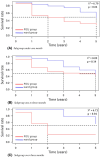The severity of the first occurrence of bronchiolitis increased the risk of developing asthma symptoms
- PMID: 39748149
- PMCID: PMC12066923
- DOI: 10.1111/apa.17565
The severity of the first occurrence of bronchiolitis increased the risk of developing asthma symptoms
Abstract
Aim: The relationship between bronchiolitis and asthma is complex. We assessed whether patients admitted to a paediatric intensive care unit (PICU) with bronchiolitis had a greater risk of developing asthma than patients admitted to a paediatric ward.
Methods: We retrospectively included children under 1 year of age, who were hospitalised for bronchiolitis for the first time at the University Hospital of Caen, France, between 2010 and 2014. The children were divided into two groups: 89 were admitted to the paediatric ward and 89 were admitted to the PICU. We wanted to assess which group developed more asthma before 6 years of age. The Global Initiative for Asthma definition was used.
Results: The median age of the 178 children (55% boys) was 32 (interquartile range 19-56) days. We found that 35% of the PICU group and 19% of the ward group had asthma at 6 years of age. The mean onset of symptoms was 3 years earlier in the PICU group than the ward group (p < 0.01). Both these findings were significant.
Conclusion: The severity of the first episode of bronchiolitis increased the risk of developing asthma symptoms. Regular follow-ups are suggested for infants admitted to PICUs for bronchiolitis.
Keywords: asthma; bronchiolitis; intensive care; preschool wheezing; risk factors.
© 2025 The Author(s). Acta Paediatrica published by John Wiley & Sons Ltd on behalf of Foundation Acta Paediatrica.
Conflict of interest statement
The authors have no conflicts of interest to declare.
Figures
Similar articles
-
Asthma risk after a pediatric intensive care unit admission for respiratory syncytial virus bronchiolitis.Pediatr Pulmonol. 2022 Jul;57(7):1677-1683. doi: 10.1002/ppul.25953. Epub 2022 Jun 2. Pediatr Pulmonol. 2022. PMID: 35579122 Free PMC article.
-
Respiratory development of 5- to 6- year-old children experiencing a first bronchiolitis episode before age one.Eur Ann Allergy Clin Immunol. 2005 Dec;37(10):392-6. Eur Ann Allergy Clin Immunol. 2005. PMID: 16528903
-
Association between multiple respiratory viral infections and pediatric intensive care unit admission among infants with bronchiolitis.Arch Pediatr. 2020 Jan;27(1):39-44. doi: 10.1016/j.arcped.2019.11.006. Epub 2019 Nov 25. Arch Pediatr. 2020. PMID: 31780096 Free PMC article.
-
[Respiratory syncytial virus infection and asthma].Allergol Immunopathol (Madr). 2001 May-Jun;29(3):140-6. doi: 10.1016/s0301-0546(01)79034-9. Allergol Immunopathol (Madr). 2001. PMID: 11434889 Review. Spanish.
-
Children born preterm admitted to paediatric intensive care for bronchiolitis: a systematic review and meta-analysis.BMC Pediatr. 2023 Jun 29;23(1):326. doi: 10.1186/s12887-023-04150-7. BMC Pediatr. 2023. PMID: 37386478 Free PMC article.
References
-
- Miller RL, Grayson MH, Strothman K. Advances in asthma: new understandings of asthma's natural history, risk factors, underlying mechanisms, and clinical management. J Allergy Clin Immunol. 2021;148:1430‐1441. - PubMed
-
- Makrinioti H, Hasegawa K, Lakoumentas J, et al. The role of respiratory syncytial virus‐ and rhinovirus‐induced bronchiolitis in recurrent wheeze and asthma‐a systematic review and meta‐analysis. Pediatr Allergy Immunol. 2022;33:e13741. - PubMed
MeSH terms
LinkOut - more resources
Full Text Sources
Medical




